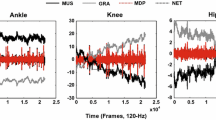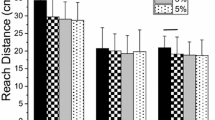Abstract
To claim that the center of mass (CM) of the body is a controlled variable of the postural system is difficult to verify experimentally. In this report, a new variant of the method of the uncontrolled manifold (UCM) hypothesis was used to evaluate CM control in response to an abrupt surface perturbation during stance. Subjects stood upright on a support surface that was displaced in the posterior direction. Support surface translations between 0.03 and 0.12 m, each lasting for 275 ms, were presented randomly. The UCM corresponding to all possible combinations of joints that are equivalent with respect to producing the average pre-perturbation anterior–posterior position of the center of mass (CMAP) were linearly estimated for each trial. At each point in time thereafter, the difference between the current joint configuration and the average pre-perturbation joint configuration was computed. This joint difference vector was then projected onto the pre-perturbation UCM as a measure of motor equivalence, and onto its complementary subspace, which represents joint combinations that lead to a different CMAP position. A similar analysis was performed related to control of the trunk’s spatial orientation. The extent to which the joint velocity vector acted to stabilize the CMAP position was also examined. Excursions of the hip and ankle joints both increased linearly with perturbation magnitude. The configuration of joints at each instance during the perturbation differed from the mean configuration prior to the perturbation, as evidenced by the joint difference vector. Most of this joint difference vector was consistent, however, with the average pre-perturbation CMAP position rather than leading to a different CMAP position. This was not the case, however, when performing this analysis with respect to the UCM corresponding to the control of the pre-perturbation trunk orientation. The projection of the instantaneous joint velocity vector also was found to lie primarily in the UCM corresponding to the pre-perturbation CMAP position, indicating that joint motion was damped in directions leading to a change away from the pre-perturbation CMAP position. These results provide quantitative support for the argument that the CM position is a planned variable of the postural system and that its control is achieved through selective, motor equivalent changes in the joint configuration in response to support surface perturbations. The results suggest that the nervous system accomplishes postural control by a control strategy that considers all DOFs. This strategy presumably resists combinations of DOFs that affect the stability of important task-relevant variables (CMAP position) while, to a large extent, freeing from control combinations of those DOFs that have no effect on the task-relevant variables (Schöner in Ecol Psychol 8:291–314, 1995).









Similar content being viewed by others
References
Abbs JH, Gracco VL (1984) Control of complex motor gestures: orofacial muscle responses to load perturbations of lip during speech. J Neurophysiol 51:705–723
Alexandrov A, Frolov AA, Horak F, Carlson-Kuhta P, Park S (2004) Biomechanical analysis of strategies of equilibrium control during human upright standing. Russ J Biomech 8:28–42
Bottaro A, Casadio M, Morasso PG, Sanguineti V (2005) Body sway during quiet standing: is it the residual chattering of an intermittent stabilization process? Hum Mov Sci 24:588–615
Cole KJ, Abbs JH (1987) Kinematic and electromyographic responses to perturbation of a rapid grasp. J Neurophysiol 57:1498–1510
Corriveau H, Hébert R, Raîche M, Dubois M-F, Prince F (2004) Postural stability in the elderly: empirical confirmation of a theoretical model. Arch Gerontol Geriatr 39:163–177
Creath T, Kiemel T, Horak F, Peterka R, Jeka J (2005) A unified view of quiet and perturbed stance: simultaneous co-existing excitable modes. Neurosci Lett 377(2):75–80
Diener HC, Horak FB, Nashner LM (1988) Influence of stimulus parameters on human postural responses. J Neurophysiol 59:1888–1905
Feitas SM, Duarte M, Latash ML (2006) Two kinematic synergies in voluntary whole-body movements during standing. J Neurophysiol 95:636–645
Gage WH, Winter DA, Frank JS, Adkin AL (2004) Kinematic and kinetic validity of the inverted pendulum model in quiet standing. Gait Posture 19:124–132
Gurfinkel VS, Ivanenko Yu P, Levik Yu S, Babakova IA (1995) Kinesthetic reference for human orthograde posture. Neuroscience 68:229–243
Horak FB (1996) Adaptation of automatic postural responses. In: Bloedel J, Ebner TJ, Wise SP (eds) Acquisition of motor behavior in vertebrates. MIT Press, Cambridge, pp 57–85
Horak F, Kuo A (2000) Postural adaptation for altered environments, tasks, and intentions. In: J Winter P Crago P (eds) Biomechanics & neural control of posture. Springer, Heidelberg, pp 267–281
Horak FB, Nashner LM (1986) Central programming of postural movements: adaptation to altered support-surface configurations. J Neurophysiol 55:1369–1381
Horak FB, Diener HC, Nashner LM (1989) Influence of central set on human postural responses. J Neurophysiol 62:841–853
Jeka J, Kiemel T, Creath R, Horak F, Peterka R (2004) Controlling human upright posture: velocity information is more accurate than position or acceleration. J Neurophysiol 92:2368–2379
Kelso JA, Tuller B, Vatikiotis-Bateson E, Fowler CA (1984) Functionally specific articulatory cooperation following jaw perturbations during speech: evidence for coordinative structures. J Exp Physcol Hum Percept Perform 10(6):812–832
Kiemel T, Oie KS, Jeka JJ (2005) The slow dynamics of postural sway are in the feedback loop. J Neurophysiol (in press)
van der Kooij H, Jacobs R, Koopman B, van der Helm F (2001) An adaptive model of sensory integration in a dynamic environment applied to human stance control. Biol Cybern 84:103–115
Krishnamoorthy V, Latash ML, Scholz JP, Zatsiorsky V (2003) Muscle synergies during shifts of the center of pressure by standing persons. Exp Brain Res 152:281–292
Krishnamoorthy V, Latash ML, Scholz JP, Zatsiorsky V (2004) Muscle modes during shifts of the center of pressure by standing persons: effect of instability and additional support. Exp Brain Res 157:18–31
Krisnamoorthy V, Yang J-F, Scholz JP (2005) Joint coordination during quiet stance: effects of vision. Exp Brain Res. online, 20 April 2005, doi: 10.1007/s00221-004-2205-6
Kuo AD (1998) A least-square estimation approach to improving the precision of inverse dynamics computations. Trans ASME Bioeng 120:148–159
Kuo AD, Zajac F (1993) Human standing posture: multi-joint movement strategies based on biomechanical constraints. Prog Brain Res 97:349–358
Latash ML, Scholz JP, Schöner G (2002) Motor control strategies revealed in the structure of motor variability. Exerc Sport Sci Rev 30:26–31
Maki BE, McIlroy WE (2005) Change-in-support balance reactions in older persons: an emerging research area of clinical importance. Neurol Clin 23:751–783
Martin V, Scholz JP, Schöner G (2004) Theory of the uncontrolled manifold: variance, self-motion, and neuronal noise. Annual meeting for the society for neuroscience Program No. 871.17, San Diego, 23–27 October 2004
Massion J (1992). Movement, posture and equilibrium: Interaction and coordination. Prog Neurobiol 38:35–56
Nashner LM, McCollum G (1985) The organization of human postural movements: a formal basis and experimental synthesis. Behav Brain Sci 8:135–150
Park S, Horak FB, Kuo AD (2004) Postural feedback responses scale with biomechanical constraints in human standing. Exp Brain Res 154:417–427
Pedrocchia A, Baronia G, Mouchninoc L, Ferrignoa G, Pedottia A, Massion J (2002) Absence of center of mass control for leg abduction in long-term weightlessness in humans. Neurosci Lett 319:172–176
Peterka RJ (2002) Sensorimotor integration in human postural control. J Neurophysiol 88:1097–118
Raibert MH (1977) Motor control and learning by the state-space model. Artificial Intelligence Laboratory, MIT, Cambridge
Reisman D, Scholz JP, Schöner G (2002) Differential joint coordination in the tasks of standing up and sitting down. J Electromyogr Kinesiol 12:493–505
Runge CF, Shupert CL, Horak FB, Zajak FE (1999) Ankle and hip postural strategies defined by joint torques. Gait Posture 10:161–170
Scholz JP, Schöner G (1999). The uncontrolled manifold concept: identifying control variables for a functional task. Exp Brain Res 3:289–306
Scholz JP, Schöner G, Latash ML (2000) Motor control of pistol shooting: identifying control variables with the uncontrolled manifold. Exp Brain Res 135(3):382–404
Scholz JP, Reisman D, Schöner G (2001) Effects of varying task constraints on solutions to joint control in sit-to-stand. Exp Brain Res 141:485–500
Scholz JP, Hsu W, Schöner G, Jeka J, Horak F (2004) Motor equivalent postural responses revealed by the UCM approach. Program No. 873.5. Abstract Viewer and itinerary planner. Washington, DC: Society for Neuroscience Online. 34th Annual meeting of the society for neuroscience, San Diego, 23–27 October
Schöner G (1995) Recent developments and problems in human movement science and their conceptual implications. Ecol Psychol 8:291–314
Tseng Y-W, Scholz JP, Schöner G (2002) Goal-equivalent joint coordination in pointing: affect of vision and arm dominance. Motor Control 6:183–204
Todorov E (2004) Optimality principles in sensorimotor control. Nat Neurosci 7:907–915
Winter DA (1990) Biomechanics and motor control of human movement, 2nd edn. Wiley, New York
Winter DA, Patla A, Prince F, Ishac M, Gielo-Perczak K (1998) Stiffness control of balance in quiet standing. J Neurophysiol 80:1211–1221
Acknowledgments
We would like to recognize Dr. Sue Park for collection of the data used in this report. Support for this research was partially provided by NIH grant NS-50880 awarded to John Scholz, NIH grants 2RO1NS35070 and 1RO1NS046065 (NSF/NIH Collaborative Research in Computational Neuroscience Program) awarded to John Jeka, and NIH grants R29DC0231201A1 and NIH grant R01AG06457 to Fay Horak.
Author information
Authors and Affiliations
Corresponding author
Rights and permissions
About this article
Cite this article
Scholz, J.P., Schöner, G., Hsu, W.L. et al. Motor equivalent control of the center of mass in response to support surface perturbations. Exp Brain Res 180, 163–179 (2007). https://doi.org/10.1007/s00221-006-0848-1
Received:
Accepted:
Published:
Issue Date:
DOI: https://doi.org/10.1007/s00221-006-0848-1




